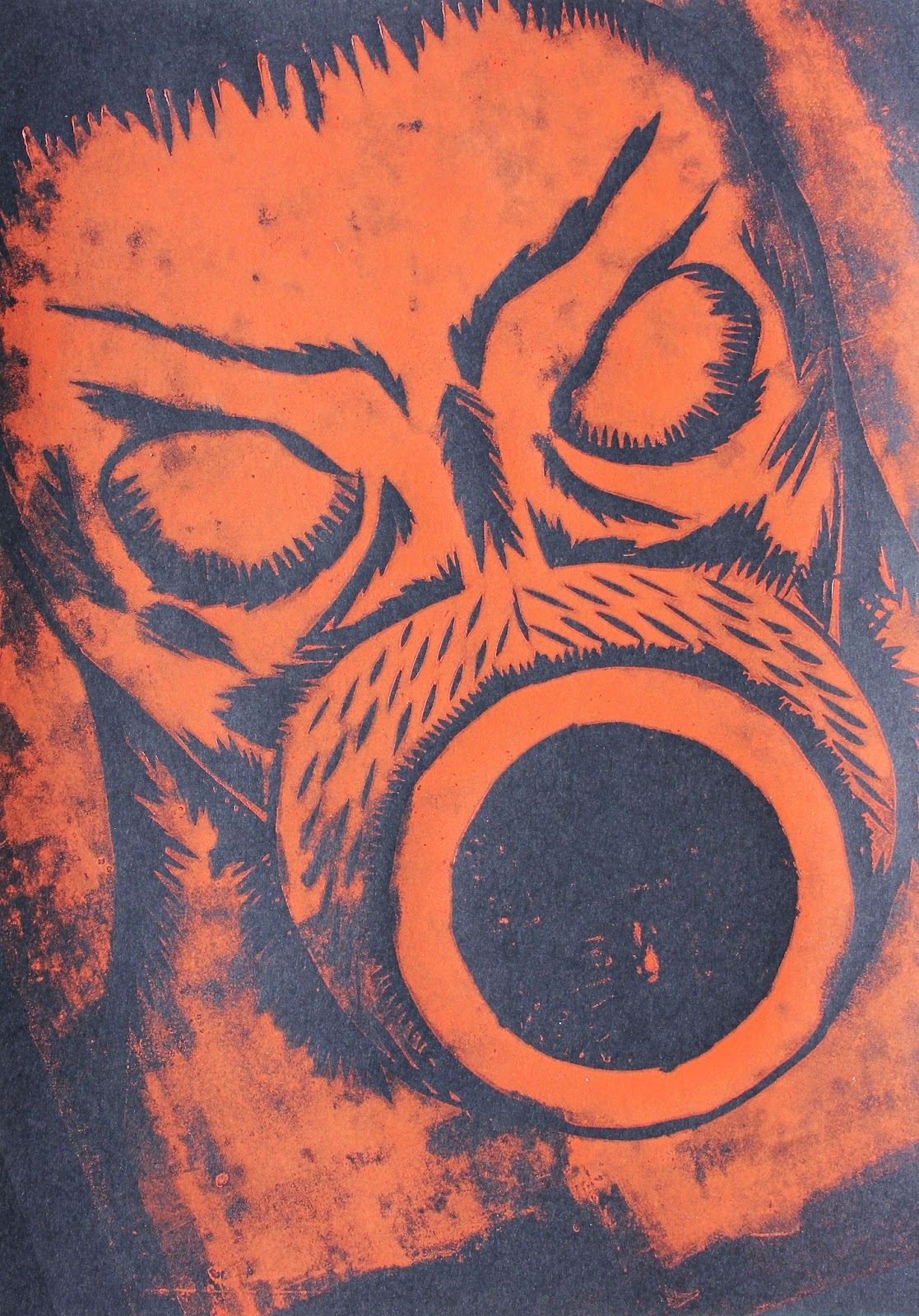Jarrod's work focuses on statistics indicating the numbers of Australian soldiers killed and wounded in World War I. Using iconic imagery, Jarrod utilised various mediums (gouache, pen, ink, enamel paint, spray paint) and techniques (stencilling, collage, lino cut, hand painting) to create his mail art contribution.
Tuesday, 1 July 2014
STUDENT WORK - BRONWYN
Bronwyn has photo-shopped portraits of contemporary monsters (including Darth Vader, The Joker and Frankenstein) onto World War I military enlistment posters. The patriotic red, white and blue colours, representative of the colours of allied flags, hint at the maelstrom of patriotic ferver used to stir citizens to enlist during World War I and are further decorated with paper cut symbols. The cards represent the luck of the draw in connection with conscription.
STUDENT ARTWORK - ELYSHA
In her first work Elysha has incorporated imagery representative of what have become iconic Australian symbols of World War I: The music score from the Last Post and images of poppies. Her second work aims to represent different perspectives of the war experience, indicating that war and the inherent casualties of war are not a one sided affair.
Elysha has also introduced an element of sentimentality with the paper cut border imitating an old fashioned photo frame to symbolise cherished memories of those lost to war and the ongoing travesty and futility of war.
Labels:
Elysha,
Illustrations,
Mail Art,
Postcards,
WWI,
WWI Artworks
STUDENT WORK - MASON
Mason's art mail (which he has entitled TATTOO FLASH #1), incorporates contemporary tattoo style drawings representative of different streams of military services (nurses, navy, army, airforce) and depictions of pre and post World War I imagery. Air combat was first introduced as a military strategy during World War I and changed the tactics and outcomes of the war. Tattoos, which are now an endemic lifestyle choice, were more identifiable with serving and seafaring men in the western society of the World War I era.
Labels:
Illustrations,
Mail Art,
Mason,
Postcards,
WWI,
WWI Artworks
STUDENT WORK - SABRINA
Sabrina has hand drawn images of soldiers and symbolic memorial flowers such as poppies, rosemary and forget-me-nots onto facsimile hand written correspondence, made the same size as a piece of note paper. These works represent the importance personal correspondence held for people during World War I, when recipients could wait months for letters to arrive with outdated news, the only personal link between the war front and the home front, apart from the dreaded telegrams.
Labels:
Illustrations,
Mail Art,
Postcards,
Sabrina,
WWI,
WWI Artworks
STUDENT WORK - GRACE
Grace's mail art portrays the internal chaos and turmoil within the mind of a person who has experienced the terror of war first hand. Sharp clinical lines slashed through the hot, stippled colours are backed by crisp white paper which represents the calm memories trying to break through the ensuing state of mental turmoil.
Grace also made a contour paper sculpture by paper cutting repeated copies of one of these images, with the reference to landscape echoing both the landscape of the mind and that of the battlefield.
Labels:
Grace,
Illustrations,
Mail Art,
Postcards,
WWI,
WWI Artworks
STUDENT WORK - DAMIEN
Damien has utilised spliced, collaged contemporary photographs of aged ex-servicemen with hand painted images of skeletons dressed in World War I military uniforms. These portrayals are based upon the life and death situations these men and their colleagues faced during their time in combat. The images also demonstrate the psychological scars carried by these men throughout their lives, influenced by crucial moments in time. The simple red line in the background is a symbolic reference to heartfelt feelings and the continuance of life in the face of death.
STUDENT WORK - CONNOR (continued)
Each student made an edition of 3 images so that original pieces of work could be sent to England and Germany to be included in student collaborative exhibitions.
Connor also made a linocut work of a gas mask as an adjunct to his mail art works.
Connor's work aims to be indicative of the chaos prevalent at the beginning of the twentieth century, with the onset of World War I and the resultant insurrection across the globe. Images of historical figures echo contemporary themes as Connor attempts to compare this earlier time with the current state of flux in the world.
Monday, 16 June 2014
Thursday, 5 June 2014
STUDENT WORK - CONNOR
Tuesday, 3 June 2014
Remember Me: The Lost Diggers of Vignacourt

The Lost Diggers of Vignacourt is an exhibition
running at The Queensland Museum (South Bank)
5th April - 20th July 2014.
The exhibition consists of 74 photographs taken from glass plates, reportedly found on a rubbish dump and placed in a trunk in a French attic and subsequently forgotten about until they were discovered 95 years later.
The original photographs, of soldiers on leave from combat on the front lines of the Somme, were taken by Vignacourt photographers Louis and Antoinette Thuillier throughout the First World War. Most of the soldiers are unknown, however, there is a large online community, aided by the Australian War Memorial, trying to once again give identities to these lost diggers.
Saturday, 24 May 2014
Subscribe to:
Comments (Atom)

















































